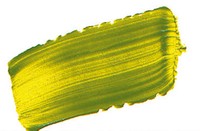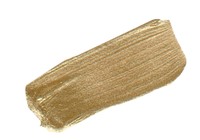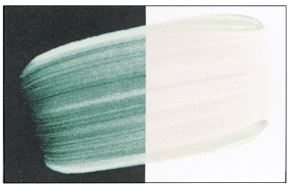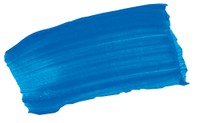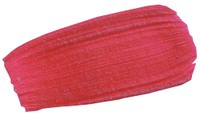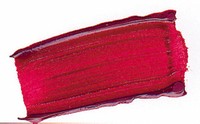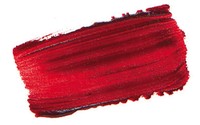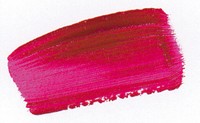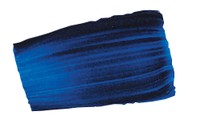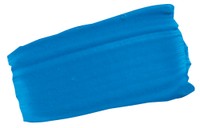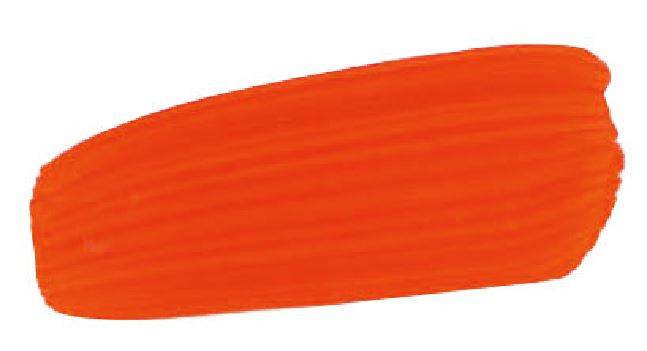Fluid Acrylic Paint

Equal the intensity of GOLDEN Heavy Body Acrylics but with an even, flowing characteristic useful for dry brush application, fine details, pouring, spraying (particularly when mixed with GOLDEN Airbrush Medium), staining techniques and many others.
Fluids are created by loading an acrylic polymer binder with concentrated levels of quality pigments for a wide selection of permanent and lightfast colours. No fillers or extenders are added to achieve the desired consistency, nor is the fluid quality achieved with additional water. GOLDEN Fluid Acrylics have the same pigment load as the Heavy Body Acrylics, but in a viscosity similar to heavy cream. Fluids allow for smooth flowing applications while retaining colour intensity, tinting strength, film integrity, and adhesion.
Fluids blend easily with all acrylic colours, and readily tint gels, mediums, gessoes and grounds. Fluid Acrylics are extremely versatile, and ideal for fine brushwork, glazing, staining, water media techniques and many more. Mix Fluid Acrylics with Airbrush Medium for airbrush application of artwork including textiles.
Golden Fluid Acrylics are available individually in 30ml bottles, and also in additional larger bottles of black and white. Two assorted sets are also available: a set of 10 30ml bottles and a set of 8 15ml bottles.
PRODUCT PROPERTIES
Mixing Fluids with other GOLDEN Products
The Fluid colours can be mixed with most of our other GOLDEN Mediums, Grounds, Gessoes, Gels and other paint lines, including Heavy Body Acrylics, High Flow Acrylics, High Load colours, Iridescent colours, Paste Paints and Matte Acrylics. By blending paint lines of different viscosities, artists can create virtually any paint consistency without sacrificing colour strength. The Heavy Body Acrylics can be thinned very effectively with water, but since the Fluids start at a lower viscosity, less water is needed. Remember: the more water added to the acrylics, the greater the subsequent shrinking of the paint layer. Too much water will reduce the binding capability of all of the acrylic paints and also tends to flatten out their sheen.
When used for applications other than staining and washes, we recommend diluting the Fluids with no more than a 1:1 ratio of Fluid Acrylic to water. When using the Fluids specifically for staining and washes, there is no limit to how much water can be added. Film integrity will automatically result when the substrate absorbs the paint mixture. Washes can also be sealed with an acrylic medium to increase overall film strength.
Brushing Quality
Fluid Acrylics load a brush more evenly than thicker paints, and they also flow consistently off the brush, allowing for longer, more uniform brush strokes. This is one of the key features of the Fluids, resulting from their low viscosity. Artists can lay down thin passages of paint that have high pigment loads; these thin passages would not be possible to achieve by diluting a paint with a higher viscosity.
When a heavier stroke is required, Fluids can be blended with any of the GOLDEN Gels. Soft, Regular, Heavy or Extra-Heavy Gels will all thicken the paint to various extents. Because of the thin consistency and potency of the Fluids, they are the easiest of all the paint systems to incorporate into powerful gel mixtures.
Pours & Puddles
The Fluids can be poured and puddled, dripped and dragged onto the canvas to achieve some unique effects. By altering the speed, the distance from the substrate and nozzle size or shape while pouring, one can control the size and shape of the resulting pour or drip. Working with different Fluid colours together, either simultaneously or at different times, can be an interesting technique.
There are a few GOLDEN mediums that work especially well with the Fluids for various pour/drip/puddle effects. Clear Tar Gel mixes with the Fluids for dripping purposes, and can yield lines that range from spider-web fine to brushstroke thick.
Thick Film Drying Considerations
When paint is being applied in relatively thick films, one must remember that all acrylic paints shrink considerably (approximately 25-40%) upon drying. This tendency, coupled with the thin consistency of the Fluids, will yield surface defects called crazes. Crazing is the result of the tremendous force exerted on the surface of the paint film as the film dries and shrinks. It can appear as rips, tears or valleys that run through the surface of the poured paint. Blending Fluids with GOLDEN Soft, Medium, Heavy or Extra Heavy Gels will significantly help to prevent crazing.
Product Gloss Variance
In keeping with the standards created by GOLDEN's Heavy Body Acrylics, when formulating the Fluid line we consciously decided not to add the flattening agents or opacifiers typically added to other acrylic paints. Such fillers are frequently added to unify the sheen of a line of paints and to make all colours uniformly opaque. We decided that each pigment would be made to its own level of matte or gloss and its own unique degree of opacity or transparency, depending upon its own intrinsic nature. These decisions have allowed the colours to retain their clearest and cleanest quality, especially when used in washes or glazes where their brilliance is displayed. It is always possible to add matting agents and other whitening materials to the product, but once added, it is impossible to take them away.
Because the Fluid Acrylics contain no flattening agents or opacifiers, it is quite evident when looking at a painted colour chart that the colours do vary in gloss. For example, the Ultramarine Blue or Raw Umber appear quite matte, while the Dioxazine Purple and Vat Orange are extremely glossy. Although some artists find this variation problematic, many artists appreciate the nuances of colour, sheen, and transparency or opacity that exist within the Fluid line.
Film Flexibility
The Fluid colours retain excellent flexibility when dry, greatly diminishing the likelihood of the cracking that occurs in other natural and synthetic polymer systems. The acrylics can absorb the constant stress and strain placed on canvas when shipped or as it expands and contracts with changes in temperature and humidity. Please note: acrylics begin to harden at 15 degrees Centigrade or 59 degrees Fahrenheit, and become quite hard at temperatures below freezing. This is especially important to remember when shipping a painting in freezing conditions or when unrolling a painting that has been kept in cold storage. The paint will not spontaneously crack when frozen, but because it will be very brittle, care should be exercised in handling. When a painting has been exposed to such cold conditions, it is important to allow it to warm sufficiently before rolling, unrolling or any other handling occurs.
Colour Range
The Main Set of colours | |
The Fluid Acrylic line, although smaller in colour range than the Heavy Body line, contains a wide variety of pigment options. Many artists have wondered why we do not include all the Heavy Body colours in the Fluid line. There are many reasons preventing us from doing so. Because of the consistency of the Fluids, some of the heavier metal pigments do not remain stable in the thinner consistency. The heavier pigments may tend to settle out, densely packing on the bottom of the container where they cannot be re-stirred very easily. Viscosity stability is a common problem, as it is often difficult to maintain such a low viscosity (thin paint) with such a high pigment load over the course of time. |
|
Green Gold | |
The Fluid Iridescent colours | |
The Fluid Iridescent colours are one of the most unique products available to artists today. They are well-known for their lustre quality and offer highly reflective metallic variations. They can be used alone or mixed with other GOLDEN colours. Adding glossy gels or mediums to Iridescent colours will also increase their lustre quality. |
|
Iridescent Bronze | |
| |
The GOLDEN Interference colours achieve their reflective properties by synthetically reproducing a natural phenomenon-the nacreous, or pearlescent, quality found in fish scales, peacock feathers or the dust of a butterfly's wing. Golden produces 6 Fluid Interference colours and four Interference Oxide colours in Fine consistency only. All of GOLDEN's Interference colours produce a lustre quality by themselves, or when mixed with other colours and mediums. | |
Interference Green | |
PIGMENT SELECTION
The Fluid line is divided among inorganic and organic pigments.
Inorganic Pigments | |
Some inorganic pigments have been around for centuries and some for millennia. They are produced either with naturally mined pigments (sienna, umber, ochre) or with synthetically manufactured pigments, (iron oxide, carbon black, etc). Inorganic pigments may also be produced using a combination of these two processes. Pigments that are both mined and manufactured include the Cadmiums, Cobalts, and Titaniums. |
|
Cobalt Blue | |
| |
The organic pigments are a group of colours that are synthetically produced through complex carbon-containing chemistry involving various materials including petroleum, coal tar and natural gas. Many of these pigments have their roots in the chemistry of the 1800's, although widespread production didn't really begin until the 1930's. Even though they have only been available for several decades, organic pigments have demonstrated remarkable abilities to withstand the impact of light and weather. |
|
Quinacridone Red | |
Pigment Selection & ASTM Standards
Every colour within the Fluid Line is approved for professional artist use according to ASTM Standards for Artist Materials. These standards regulate paint consistency and demand fineness and lightfastness of chosen pigments, use of 100% acrylic binder, freeze-thaw stability, and accuracy of labelling for pigments used. Evaluation by an approved toxicologist is required.
Of the 51 colours currently in the Fluid line, 45 are considered excellent in lightfastness (the ability to withstand colour change due to exposure to light). The remaining 6 are rated very good for lightfastness. GOLDEN does not use any colours within the Fluid line rated less than very good. Those colours rated as very good include Green Gold, Naphthol Red Light, Naphthol Red Medium, Hansa Yellow Light, Permanent Green Light, and Dioxazine Purple.
PIGMENT FAMILIES
The Quinacridone Family | |
The GOLDEN Acrylic lines contain more Quinacridones than any other acrylic line of paint. Quinacridone pigments produce seven intense colours ranging from deep yellow to vibrant violet. All of the Quinacridones, because of their vibrant undertones and high transparencies, tend to be excellent mixing colours. They tend not to muddy or grey, retaining their brightness. |
|
Quinacridone Crimson | |
| |
Quinacridone Burnt Orange | |
| |
Quinacridone Magenta | |
The Phthalocyanine Family | |
The Phthalocyanines are known as the oldest organic pigments. The GOLDEN Fluid line contains 5 Phthalocyanine colours, including Phthalo Green (Yellow Shade) and Phthalo Green (Blue Shade), Turquois (Phthalo), and two Phthalo Blues, (Green Shade) and (Red Shade). These different Phthalocyanine colours actually contain the various pigment forms of the Phthalocyanine group. |
|
Phthalo Blue (Red Shade) | |
The Cobalt Family | |
The Cobalt Fluid colours include Cerulean Blue and Blue Deep (these contain both Cobalt and Chromium), and Cobalt Blue. |
|
Cerulean Blue | |
The Pyrrole Family | |
The Pyrrole family is one of the newer pigment families to be developed. The Pyrroles are almost as opaque and, in fact, brighter than the Cadmium colours. Pyrrole Orange, Pyrrole Red Light, and Pyrrole Red exhibit excellent opacity and lightfastness. They also offer clean mixing with other organics, unlike their Cadmium counterparts, which produce muddier blends | |
Pyrrole Orange | |











